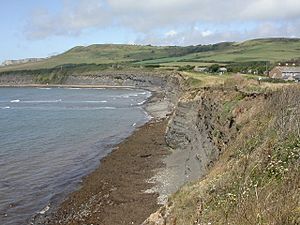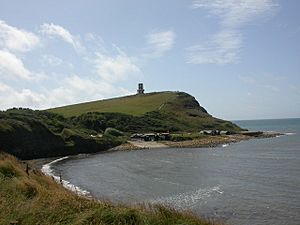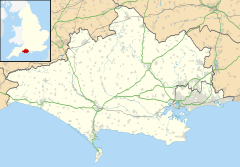Kimmeridge Bay facts for kids
Quick facts for kids Kimmeridge Bay |
|
|---|---|
 Kimmeridge Bay cliffs, looking northwest |
|
| OS grid reference | SY906789 |
| Civil parish |
|
| District |
|
| Shire county | |
| Region | |
| Country | England |
| Sovereign state | United Kingdom |
| Post town | WAREHAM |
| Postcode district | BH20 |
| Police | Dorset |
| Fire | Dorset |
| Ambulance | South Western |
| EU Parliament | South West England |
| UK Parliament |
|

Kimmeridge Bay is a beautiful bay located on the Isle of Purbeck. This area is a peninsula on the English Channel coast in Dorset, England. It is very close to the village of Kimmeridge. The bay is famous for its amazing fossils. You can see many of these fossils at The Etches Collection in Kimmeridge village. These were found by Steve Etches over 30 years! Kimmeridge Bay is a popular spot for tourists to visit the coast. To the east, you'll find the Kimmeridge Ledges. Here, fossils can be discovered in the flat clay beds.
Contents
Discovering Kimmeridge Bay
Kimmeridge Bay is a special part of the Jurassic Coast. This entire coastline is a World Heritage Site. This means it's recognized globally for its unique natural importance. The coast is also a Site of Special Scientific Interest. This protects its wildlife and geology. The whole area is also part of the Dorset Area of Outstanding Natural Beauty. This means it's a beautiful landscape that is protected.
Kimmeridge is the main place where Kimmeridge clay was first studied. This type of rock covers most of the area. Inside the clay, there are layers of bituminous shale. This is a rock that can contain oil. An oil well has been working here since 1959. The bay itself is shaped like a half-circle. It faces southwest towards the sea.
Exploring the Shore
The bay has low cliffs made of Kimmeridge clay. Below these cliffs, there's a large flat rock area called a wave-cut platform. There is also a rocky shore with many rock pools. These pools are home to lots of different sea creatures. Kimmeridge Bay is a great place for surfers and divers.
The Purbeck Marine Wildlife Reserve is also located here. It works to protect the sea life. The Fine Foundation Marine Centre is also part of this reserve.
Amazing Geology and Fossils
The rocks around Kimmeridge Bay are world-famous. Most of the bedrock formed during the Late Jurassic period. This was a very long time ago! On top of these older rocks, you can find newer Quaternary deposits. Most of the rock here is Kimmeridge clay. However, the top of Smedmore Hill has Portland stone.
Between the Portland stone and the Kimmeridge clay, there's a thin layer of Portland sand. Landslides from the Portland stone cover many of the steep slopes. Within the Kimmeridge clay, you'll find layers of bituminous shale and dolomite. These form flat ledges in Kimmeridge Bay. You can see them when the tide is low.
Kimmeridge gives its name to the Kimmeridgian period. This is a part of the Jurassic period. It's named after Kimmeridge because of the amazing cliffs and fossils found here. Kimmeridge is also the main place where the Kimmeridge Clay formation was first studied. This rock formation is found across southern England. It's important because it's one of the rocks that contain oil and gas. These are found in areas like the Wessex and North Sea Basins.
The Kimmeridge Oil Field
The Kimmeridge Oil Field is just northwest of Kimmeridge Bay. On the cliff west of the village, you can see a special oil pump. It's often called a "nodding donkey." This pump has been working non-stop since the late 1950s. This makes it the oldest working oil pump in the UK!
The well pumps out about 65 barrels of oil each day. This oil comes from rocks deep underground. These rocks are about 1,150 feet below the cliff. The well has worked for so long because it's connected to many oil reserves. However, the amount of oil it produces is slowly decreasing each year. The oil is then taken by truck to another site called Wytch Farm. From there, it's sent through a pipe to a refinery near Southampton.
Surfing at Kimmeridge Bay
Kimmeridge Bay is also a spot for surfing. It doesn't get big waves very often. This is because it's not directly exposed to the huge waves from the Atlantic Ocean. But when the conditions are just right, it can produce some great waves!
Below the cliffs to the east are the Kimmeridge Ledges. Here, you can find slow waves that break both left and right. The right-hand waves can go for 70 yards or more into the bay! To the west is the Broad Bench area. This is inside a military firing range called the Lulworth Ranges. You can only go there when the ranges are open to the public.



